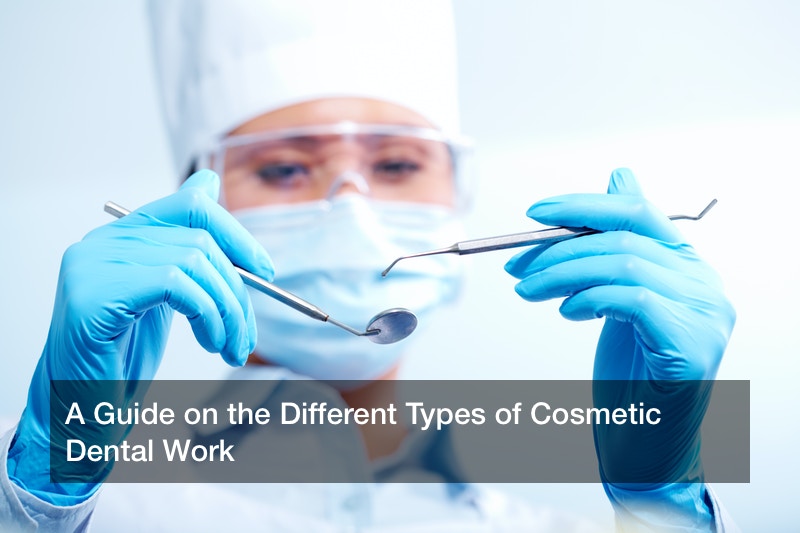

Your oral health, just like your general health, is essential and demands proper care. To this end, the American Dental Association recommends brushing twice a day. They also recommend limiting the intake of sugary foods, acidic drinks such as soft drinks, and protecting your teeth from injury.
Good oral hygiene improves your smile and general confidence. However, this can be complemented by cosmetic dental work. Here are the main types of cosmetic dental work:
Dental bonding
This procedure involves applying a tooth-colored resin, molded, and smoothed to the correct shape of the tooth. The resin is polished and shaped to match the surrounding teeth for uniformity and proper alignment. Dental bonding is often used as a solution for:
- Stained teeth
- Broken teeth
- Chipped teeth
Dental bonding also helps with closing gaps and changing the shape of teeth, as well as protecting the roots that have been exposed due to gum injury.
The bonding procedure should take no more than 30 minutes for a tooth. It is also the cheapest dental cosmetic work.
The procedure, however, has some risks. Chewing fingernails, plastic materials, and ice can ruin the resin. Smoking, taking tea or coffee can also destroy the substrate when done within the first 48 hours after the procedure.
Dental Implants
Lost a tooth? No worries. Dental implants are made of metal and used to replace a missing tooth.
The titanium-made implant is inserted on the jawbone. The implant acts as a root that anchors the artificial tooth. Since the implants fuse with the jawbone, they give the artificial tooth strong support, which prevents them from moving while eating or talking.
American Dental Association (ADA) recommends either endosteal or subperiosteal implants. However, this type of dental work can be a bit costly.
Dental Veneers
These wafer-thin shells are made of porcelain. They are mounted on the front side of the teeth for conditions such as discolored teeth, slightly crooked teeth, chipped teeth, and to cover gaps.
Veneers are permanent, and the process is irreversible. Veneers can be effective for more than 10 years.
Proper care for veneers include:
- Flossing.
- Frequently brushing using non-abrasive fluoride toothpaste.
- Limiting strain-inducing foods and drinks such as coffee.
The procedure can cost between $800 and $2,000 per tooth.
Teeth Whitening
Also known as teeth bleaching, teeth whitening is crucial for a brighter smile.
Whitening agents such as toothpaste, over-the-counter gels, strips, and strays are suitable. Your family dentist will advise on the most effective method for you.
For people with healthy, unrestored teeth and gums, teeth whitening will suffice. Individuals with yellow-toned teeth have shown exceptional results.
Dental Crowns
Dental crowns, or ‘caps,’ are made and placed over weak teeth to improve their shape, size, strength, and appearance. They act as remedies for teeth that are severely decayed, broken, or chipped.
Crowns are made of metal, porcelain, ceramic, or resin fused on metal to withstand the pressure during biting or chewing. Dentists fill down the affected teeth and cement the crown over it.
Getting used to crowned teeth might take some time. But eventually, they’ll look, feel and function normally.
Teeth Shaping
Teeth shaping involves reshaping the teeth by filling or removing part of the enamel, hence the name ‘enamel shaping’.
Teeth shaping is done mostly to improve appearance. Typical patients are ones with uneven or slightly overcrowded teeth. For improved efficiency, most dentists in Gainesville VA recommend that teeth shaping be done together with teeth whitening and teeth bonding.
Orthodontics
Commonly known as braces, Invisalign is an excellent remedy for crooked or misaligned teeth.
Braces slowly apply steady pressure and move the teeth into proper alignment. As pressure is applied, the teeth move, and bone socket changes shape.
There are a variety of braces to explore, with the most common being metal braces. Invisible braces are placed behind the teeth from where they gradually move the teeth into proper alignment.
Bottom-Line
Caring for your oral health involves much more than routinely brushing your teeth and avoiding some foods. Given that time and again, we might suffer tooth loss, discolored teeth, misaligned teeth, gaps between teeth, or decay. Not to worry though, because in most case rectifying the problem only requires a very small amount of dental work.

